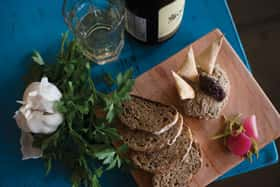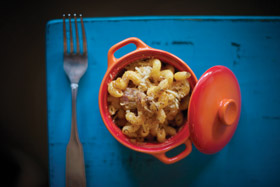 Tasca Tasca
Tasca Tasca
122 West Napa St.
Sonoma, CA 95476
(707) 996-TAPA
www.tascatasca.com
New Portuguese cuisine
Noon-midnight daily
Plates $15, $24 or $32
Portuguese wine, Port and Madiera; some beer, cider and cocktails
Walking distance from Sonoma’s central plaza, Tasca Tasca welcomes patrons into a cozy, rustic setting, deeper than it is wide, with small tables, a long dining bar and window seating. Tabletops made from old wine boxes added another fun element to the room.
When we visited on a warm September evening, the front windows were open to the street and the crowd was a low-key mixture of locals and tourists. Real Madrid (led by Portuguese star Cristinao Ronaldo) was trouncing an opponent on the large television above the bar, and laughter and friendly shouts could be heard from the open kitchen at the back of the room.
 “Tasca” means tavern or pub in Portuguese, and Tasca Tasca represents Chef Manuel Azevedo’s favorite style of eating—snacking on a wide variety of delicious food while drinking unique wine. A champion of Portuguese cuisine, Azevedo’s culinary style celebrates the varied and complex flavors of his birthplace. This restaurant is Azevedo’s third Wine Country restaurant (he also owns LaSalette and Cafe Lucia).
“Tasca” means tavern or pub in Portuguese, and Tasca Tasca represents Chef Manuel Azevedo’s favorite style of eating—snacking on a wide variety of delicious food while drinking unique wine. A champion of Portuguese cuisine, Azevedo’s culinary style celebrates the varied and complex flavors of his birthplace. This restaurant is Azevedo’s third Wine Country restaurant (he also owns LaSalette and Cafe Lucia).
One of Tasca Tasca’s unique features is an extensive list of all Portuguese wines. We opted for pre-established flights: one of white wines and one of reds; each included a trio of three-ounce pours. Whites included Quinta da Lixa Vinho Verde (light and fruity, with a hint of effervescence), Pomares Douro (oily mouthfeel, round with warmer stone fruit) and Esporão Alentejo (oaky and full-bodied). Red wines included Periquita reserve Setubal (vanilla, plums and chocolate), Trinca Bolotas Alentejo (full-bodied with intense aromatics) and Prazo de Roriz Douro (deep, spicy and a bit jammy). All the wines were similar to varieties I’m more familiar with, but their slight differences made them exciting to try.
The menu of tasting plates includes four savory (cheese, garden, sea and land) and one sweet category. Diners choose three, five or seven items from any category, and all are served at once on a wood board. Food is meant to be shared, and the combinations are tantalizing. We sampled a bit of everything.
The queijo fresco cheese is similar in texture to a burratta, fresh and creamy with a slightly salty exterior. It was served with tomato jam and whole grain crostini for a lovely opener. A second cheese, Alchadina broncha, was deliciously drizzled with honey; dry and crumbly, it had a light flavor accented by a finishing tang.
Caldo verde, “Portugal’s national soup,” is made with chicken broth, thickened by potato and brightenedwith fresh herbs. Slices of chouriço (a zesty Portuguese sausage) added depth. Potatoes “ao murro,” baked fingerlings in truffle butter with garlic and herbs, were delicate and hearty all at once. Slices of smoked duck breast (in Muscatel glaze) were cooked perfectly with lovely sweet and smoky flavors. A sweet gherkin and dollop of mustard were perfect accents.
Kale salad was a happy surprise. The kale was shredded and lightly marinated with an anchovy dressing, and its deep green flavor became the star, complimented by St. George cheese (similar in texture and flavor to shredded parmesean) and bits of tomato and chouriço. A pâté of sardines, topped with red onion jam, was a lovely treat (briney and rustic) when smeared on a crostini. Marinated mussels were a tantalizing orange color, thanks to saffron vinaigrette. They were rich and meaty, served on a bed of frisee that helped trap the saffron goodness—definitely one of my favorite pieces of an overall enjoyable meal.
We shared a dish of housemade cobblestone road ice cream (similar to traditional rocky road and topped with a carmelized fig—just, yum), then opted for an accompanied Port tasting. Three pours showcased different styles of fortified wine, and each was partnered with a small tasty bite that really brought the nuances home. It was truly the highlight of the experience.
Taylor Fladgate late bottled Port vintage 2010, darkest in color and velvety in texture, was paired with a bold, sharp blue cheese. The wine softened the cheese’s sharpness and the cheese made the wine taste sweeter. Feuerheerd 10-year tawny Port tasted like burnt caramel and matched beautifully with a “cake” of pressed fig and nuts. The pièce de résistance was Broadbent Rainwater Madiera, which is baked in the barrel for a honeyed, woodsy flavor. Put a wedge of dark chocolate in your mouth then take a sip: the melting chocolate blends with the wine for a lasting (and memorable) finish.



